30-Year Friendship Finds a Research Home Through Department of Energy's Visiting Faculty Program
Novel DOE Office of Science Program Builds Bridges Between Minority-Serving Institutions and National Laboratories
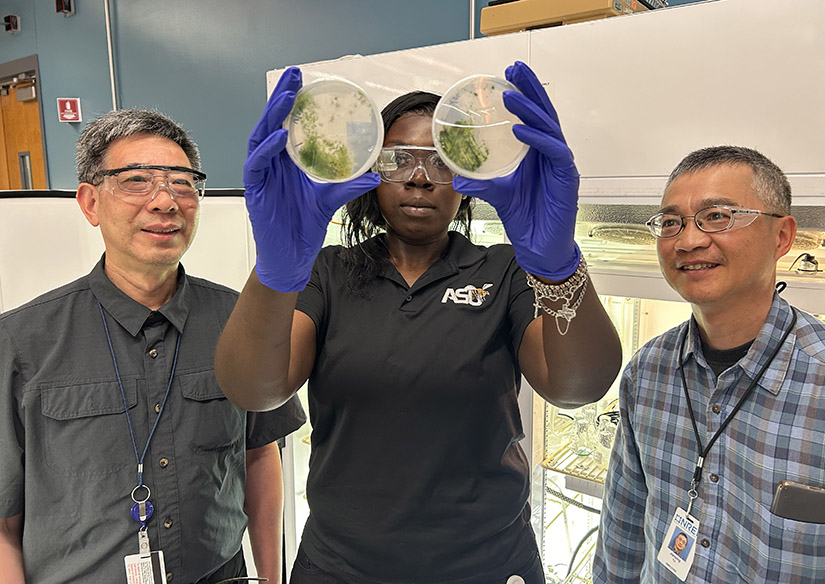
For nearly 30 years, two good friends dreamed of working together on a research project diving deeper into the mysteries of photosynthesis. This dream would begin to take shape through an innovative U.S. Department of Energy (DOE) Office of Science Workforce Development for Teachers and Scientists (WDTS) program while leading to research opportunities for historically marginalized science, technology, engineering, and mathematics (STEM) research students.
Harvey Hou, an Alabama State University (ASU) chemistry professor, and Jianping Yu, a National Renewable Energy Laboratory (NREL) molecular biology researcher, first met as postdoctoral researchers. Through the years, they remained in touch at research conferences, always sharing knowledge with each other and their peers. Yet, the one thing that eluded them was the ability to work together on a research project.
“We came up with several ideas to collaborate over the years, but the timing never worked out,” Yu said. “All of this began to change for the better when Harvey was chosen for DOE’s Office of Science WDTS Visiting Faculty Program.”
DOE Visiting Faculty Program: Powering STEM Collaboration With Historically Marginalized Institutions and National Laboratories
DOE’s Visiting Faculty Program (VFP) is designed for full-time faculty members from institutions historically underrepresented in STEM research. The program provides opportunities to enhance research competitiveness and innovative STEM learning for students through a funded collaborative experience with a DOE national laboratory.
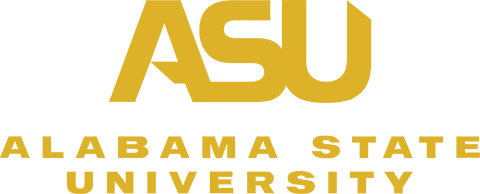
Founded in 1867 in Marion, Alabama, Alabama State University started as the Lincoln Normal School with $500 raised by nine formerly enslaved men now known as the Marion Nine. Today, the university is in Montgomery, Alabama, and offers more than 60 undergraduate and graduate degree programs for students of all races. Image from Alabama State University
As full-time faculty at ASU, one of the nation’s oldest institutions of higher education founded for Black Americans, Hou was eligible to apply for the VFP. He was accepted and, in the summer of 2023, headed to NREL to collaborate in the lab with his colleague Yu.
The common thread that entwined Hou’s and Yu’s history together was the study of photosynthesis—nature’s ability for plants or algae to turn light energy, carbon dioxide, and water into chemical energy.
Hou studies and teaches his ASU students the “light” stage of photosynthesis and how the electron transfer reactions convert and store light energy as chemical bonds. Yu studies the “metabolism” stage of photosynthesis and how carbon dioxide is reduced to form organic carbon compounds like sugars or starches.
“I really knew almost nothing of the metabolism stage of photosynthesis and how energy was regulated via carbon metabolism by the organism,” Hou said. “And now I had the opportunity to visit NREL and work alongside my good friend Jianping, who is a leading expert in carbon metabolism and energy management within microalgae.”
NREL-ASU Research Collaboration Manifests Research Papers, Energy Earthshots Award, and New Friends
Yu and his team at NREL, including researcher Eric Schaedig and postdoctoral researcher Jacob Sebesta, study the cellular energy regulation mechanisms of cyanobacteria, also known as blue-green algae. The goal for them is to understand how these microalgae could be modified to produce chemical precursors for low-carbon biofertilizers or biofuels at scale. Hou would now be able to experience and work on this cutting-edge research.
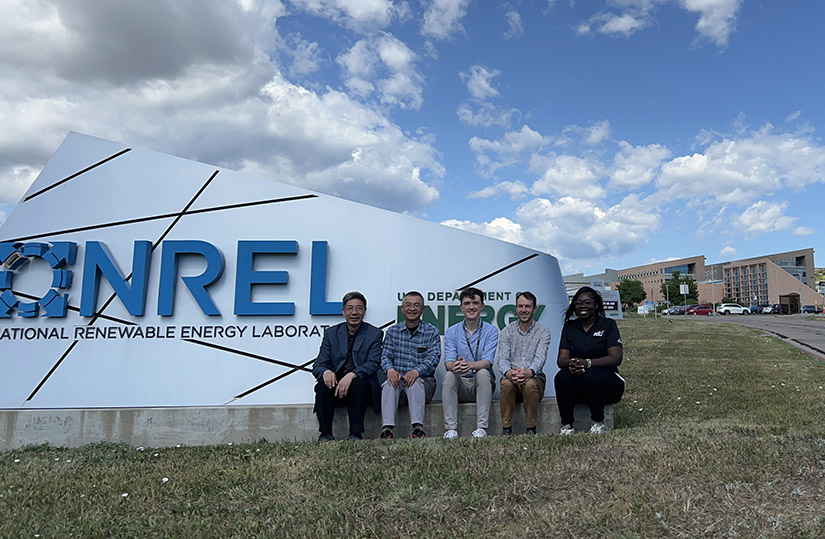
The DOE Office of Science Visiting Faculty Program enabled old friends to collaborate while creating new friendships. From left to right, ASU professor Harvey Hou; NREL researchers Jianping Yu, Eric Schaedig, and Jacob Sebesta; and ASU student Lydia Davies-Balogun. Photo from Harvey Hou, NREL
“The research happening at NREL in Jianping’s lab using genetically engineered microalgae to produce biobased fuels and products is innovative," Hou said. “For me, being able to use this new research project in the classroom while inspiring ASU students to explore new frontiers in bioenergy research is invaluable.”
Throughout Hou’s 10-week visit in 2023, the collaboration between old friends and new ones resulted in tangible progress. They published a paper together, “Polyphosphate Kinase Deletion Increases Laboratory Productivity in Cyanobacteria,” in Frontiers in Plant Science, which explored how cyanobacteria regulate energy.
In late 2023, the NREL and ASU team, in partnership with lead principal investigator Himadri Pakrasi from Washington University in St. Louis, won a DOE Science Foundations for Energy Earthshots award. This provides funding for three years and focuses on a project to produce green nitrogen from cyanobacteria for production of biofertilizers. Current industry methods for producing nitrogen fertilizers are extremely energy-intensive and have high greenhouse gas emissions.
But it does not stop there. These clean energy research methods optimized in the lab by Hou and Yu are also being shared with other historically Black colleges and universities (HBCUs). This year, at the 79th Joint Meeting of Beta Kappa Chi and the National Institute of Science, which was hosted by ASU, the theme was Sustainable STEM: Resilience in a Changing Climate. Hou, Yu, and Pakrasi developed a workshop, titled “Energy Science: Challenges and Opportunities,” and shared the idea, acquired from DOE’s Energy Earthshots research, of using cyanobacteria to produce clean energy.
“My time at NREL and collaboration with Jianping have really opened new avenues for me to investigate photosynthetic mechanisms,” Hou said. “It’s also been rewarding to make a difference in training HBCU students to enter the workforce in clean energy technology.”
This research collaboration enabled by DOE’s VFP has not only strengthened Hou’s research but also made a substantial difference in the learning lives of his ASU STEM students.
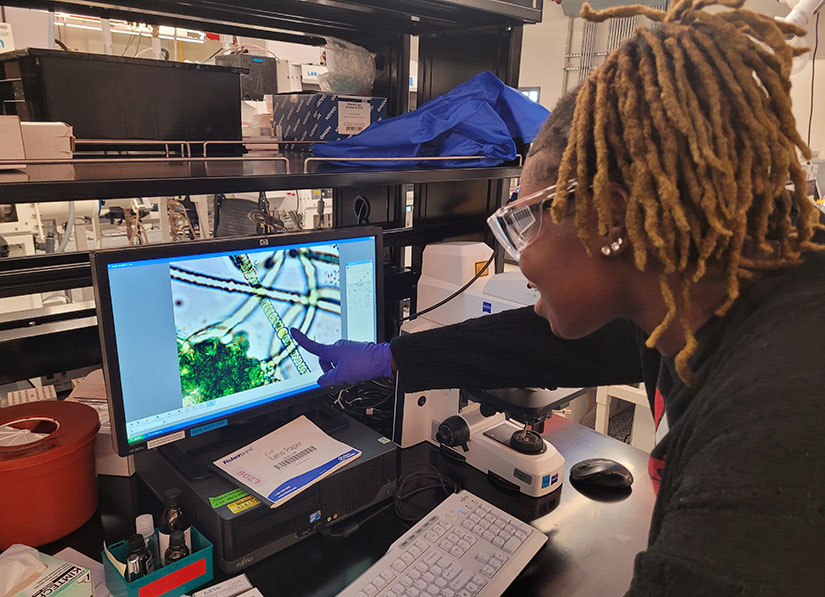
ASU student Lydia Davies-Balogun views microscopic images in the NREL Research and Innovation Laboratory (RAIL) to aid in isolating the cyanobacteria strains. Photo by Eric Schaedig, NREL
Realizing the VFP Vision: Knowledge Transfer of National Lab Clean Energy Research to HBCU STEM Students
The vision of DOE’s VFP is to transport collaborative and innovative DOE national lab research back to institutions supporting underrepresented STEM students. The visiting faculty member brings the knowledge back to their university to share with students. In addition, visiting faculty members participating in the VFP during a summer term can invite up to two students to join the research project at the DOE national laboratory as an intern.
After a selection process, Hou chose a student from his class, Lydia Davies-Balogun. She was the first ASU student to intern at a DOE national laboratory. And while being the first person to attempt a goal can be daunting, Davies-Balogun found herself in a supportive environment at NREL.
“When I first arrived at NREL, I was nervous after talking to some interns, because I didn’t have the level of research experience that the other interns did,” said Davies-Balogun. “But after I started working in the lab, everybody was so willing to teach me new things. This did a lot to help boost my confidence and the experience here has truly been greater than what I ever expected.”
Davies-Balogun’s teacher was excited to have her join him during this NREL experience.
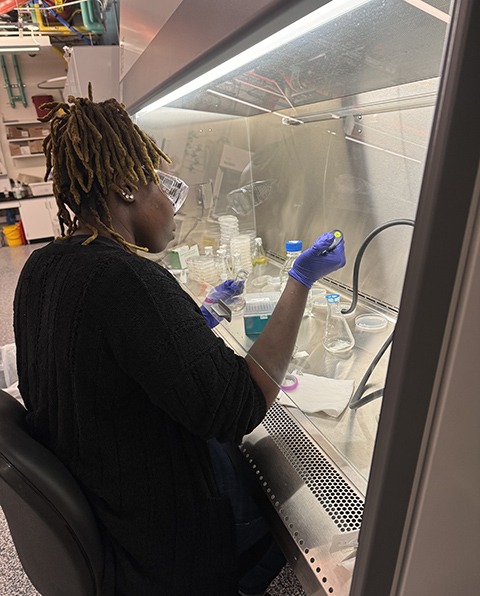
ASU intern Davis-Balogun filtering bacteria samples in NREL’s Research and Innovation Laboratory. Photo by Eric Schaedig, NREL
“Having Lydia here at NREL to experience this with me is a really significant success for her and the university,” Hou said. “She arrived before I did this summer, and Jianping and his team members, Eric Schaedig and Jacob Sebesta, have been helping Lydia hone her research skills. She has made tremendous progress in a just a couple of weeks and is going above and beyond with this internship.”
Davies-Balogun is being mentored by Yu while exploring the energy-generating mysteries of cyanobacteria. They are working in the field and the lab to isolate those microbes that can convert nitrogen into ammonia during photosynthetic processes.
“After we collected the water samples, we placed them into nitrogen-deficient media. The presence of external nitrogen can inhibit the formation of heterocysts, a type of cyanobacterial cell that forms during the absence of nitrogen,” Davies-Balogun said. “And after about seven days the bacteria started to show signs of growth, and we were able to view the heterocysts under the microscope. We knew at that point that we had nitrogen-fixing cyanobacteria in our water samples.”
Davies-Balogun has a dream of being an orthopedic doctor; however, she just may have been bitten by the research bug with her experience isolating cyanobacteria at NREL.
“I like the attitude of the people that work here,” Davies-Balogun said. “You can have a new idea and be completely unsure if it will work. But everybody here is accustomed to just trying it out. Having the freedom to try different things is what makes research science higher on the list as a profession for me.”
Whether it be old acquaintances finally working on research together and competing for funding, the first STEM student at ASU to intern at a DOE national laboratory, or a knowledge share of advanced clean energy research with ASU students and the larger HBCU community, the impact of DOE’s VFP will reverberate for years to come.
Learn more about NREL’s algal research, NREL’s programs for teachers, and DOE’s Visiting Faculty Program.
Last Updated May 28, 2025
